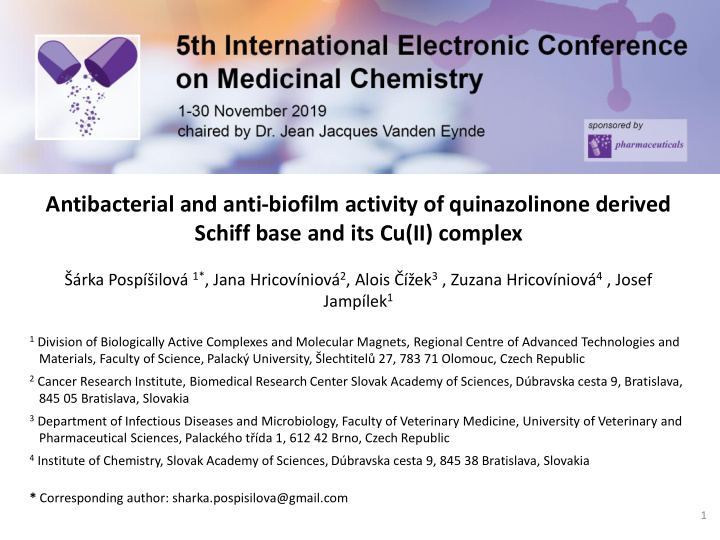



Antibacterial and anti-biofilm activity of quinazolinone derived Schiff base and its Cu(II) complex Šárka Pospíšilová 1* , Jana Hricovíniová 2 , Alois Čížek 3 , Zuzana Hricovíniová 4 , Josef Jampílek 1 1 Division of Biologically Active Complexes and Molecular Magnets, Regional Centre of Advanced Technologies and Materials, Faculty of Science, Palacký University, Šlechtitelů 27, 783 71 Olomouc, Czech Republic 2 Cancer Research Institute, Biomedical Research Center Slovak Academy of Sciences, Dúbravska cesta 9, Bratislava, 845 05 Bratislava, Slovakia 3 Department of Infectious Diseases and Microbiology, Faculty of Veterinary Medicine, University of Veterinary and Pharmaceutical Sciences, Palackého třída 1, 612 42 Brno, Czech Republic 4 Institute of Chemistry, Slovak Academy of Sciences, Dúbravska cesta 9, 845 38 Bratislava, Slovakia * Corresponding author: sharka.pospisilova@gmail.com 1
Antibacterial and anti-biofilm activity of quinazolinone derived Schiff base and its Cu(II) complex Graphical Abstract 2
Introduction • Resistant bacteria are still an important global problem, which causes at least 700 000 deaths per year. • Treating multi-resistant infections is not only more complicated, but also more expensive. • Development of new active and safe antibacterial agents is necessary to overcome the risk of losing therapeutic perspectives for treating serious life- threatening infections. • Schiff bases are a group of compounds with wide spectrum of activity such as antibacterial, anticancer or antioxidant. Due to their structure they are able to serve as ligands in metal complexes, which usually have higher activity than ligands alone. • The aim of this work was to evaluate antibacterial and anti-biofilm activity of quinazolinone-based Schiff base: 3-[(2-hydroxy-5-nitrobenzylidene)- amino]-2-(2-hydroxy-5-nitrophenyl)-2,3-dihydroquinazolin-4(1 H )-one and its Cu(II) complex.
Methods • Minimum inhibitory concentrations (MICs) were tested by broth dilution method in microtitration plates. After incubation, the lowest concentration which inhibited growing od bacteria was evaluated visually. MICs against M. tuberculosis were examined using resazurin • Following incubation, sub-cultivation of aliquots onto agar plates was used to assess minimum bactericidal concentration (MBCs) • Method of time-kill curves was used to study dynamics of antibacterial activity against S. aureus ATCC 29213. • Formed biofilm cultivated for 48 hours in tryptic soy broth with 2% of glucose was treated by different concentration of tested compound for 24 hours. Minimum biofilm eradication concentration (MBEC 90 ) was counted as the lowest concentration of the compound which increased viability of the cells by 90% compared to the growth control. Viability was measured by MTT method. 4
Results and discussion Antibacterial activity of tested compounds Table 1 : Minimum inhibitory concentration (MIC [ μg /mL]) / minimum bactericidal concentration (MBC [ μg /mL]) against selected bacterial isolates. Strain/isolate Ligand Cu(II) complex S. aureus ATCC 29213 32/128 16/ >256 MRSA 63718 64 /128 64/64 MRSA SA 630 16/16 8/8 MRSA SA 3202 64/128 16/16 E. faecalis ATCC 29212 256/256 128/>256 M. tuberculosis H37Ra 64 32 M. smegmatis ATCC 700084 128/128 64/64 M. kansasii DSM 44162 128/128 128/128 M. marinum CAMP 5644 64 64 5
Results and discussion Antibacterial activity of tested compounds • The compounds showed good antibacterial activity against staphylococci including methicillin resistant isolates. • Antimycobacterial activity was higher in the case of slowly growing mycobacteria as M. marinum and M. tuberculosis. Differences among the strains could be caused by differences in their cell wall components. • The activity of Cu(II) complex was slightly higher than the activity of the ligand. • Enterococcus was less sensitive than staphylococci, which can be caused its higher intrinsic resistance to antibacterial agents in general. 6
Results and discussion Dynamics of antibacterial activity Graph 1 : Dynamics of antibacterial activity of both tested compounds against S. aureus ATCC 29213. 7
Results and discussion Dynamics of antibacterial activity • All of the compounds demonstrated only bacteriostatic activity, because the decrease of CFU/mL in all times and concentrations was < 3log compared to the time 0. • Results were analysed using two-way ANOVA following Tukey test . At P = 0.05, the only statistically significant difference in activity was observed between ligand in concentration 1 MIC /24 hours and complex 2 – 4 MIC/24 hours. • Thus overall, the difference in bactericidal activity among different concentration of ligands and complexes in different times is not statistically significant. 8
Results and discussion Anti-biofilm activity against S. aureus ATCC 29213 Table 2 : Comparison of MICs [ μg /mL], MBCs [ μg /mL]) and MBECs 90 [ μg /mL]) of tested compounds against S. aureus ATCC 29213. Comp. MIC MBC MBEC 90 Ligand 32 128 64 Cu (II) complex 16 >256 32 Graph 2 : Eradication activity of tested compounds against formed staphylococcal biofilm. 9
Results and discussion Anti-biofilm activity against S. aureus ATCC 29213 • The compounds showed very good activity against pre-formed staphylococcal biofilm, when the MBEC 90 was only 2-fold higher than MIC against planktonic cells. • In concentration equal to MICs the anti-biofilm activity of Cu(II) complex was only slightly higher than activity of the ligand ( 87.3 ± 4% vs. 81.7 ± 13.7%). • In the concentration equal to ½ MIC, the Cu(II) complex reduced viability of the film by 66.4 ± 10.6%, but the ligand did not have any effect. • Cu(II) complex is an interesting compound for deeper research in the field of anti- biofilm active agents. 10
Conclusions • Quinazolinone – based Schiff base and its Cu(II) complex were tested against a spectrum of bacterial pathogens, as well as against staphylococcal biofilm. • The compounds showed good activity against staphylococci, which was defined as bacteriostatic using time-kill method. • Anti-biofilm activity of these compounds is very promising, because the concentration needed to eradicate 90% of matured staphylococcal biofilm was only 2-fold higher than MICs against planktonic cells. • The compounds are very perspective antibacterial agents and their features should be analysed deeper in following studies. 11
Acknowledgments Regionální centrum pokročilých technologií a materiálů This study was supported by the Ministry of Education of the Czech Republic (LO1305) and by project VEGA 2/0022/18. 12
Recommend
More recommend